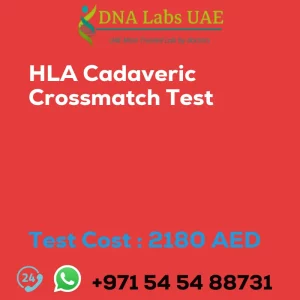HLA Mixed Antibody Screen – PRA Class I II and MICA Test
Test Name: HLA MIXED ANTIBODY SCREEN – PRA CLASS I II and MICA Test
Components:
- PRA Class I
- PRA Class II
- Anti MICA antibodies
Price: 1870.0 AED
Sample Condition: 3 mL (1.5 mL min.) serum from 1 SST. Only Recipient sample required. Ship refrigerated or frozen. Provide brief clinical history.
Report Delivery: 10-12 days
Method: Luminex X-Map technology
Test type: Transplantation
Doctor: Nephrologist, Gastroenterologist, Surgeon
Test Department:
Pre Test Information: Only Recipient sample required. Provide brief clinical history.
Test Details:
The HLA Mixed Antibody Screen – PRA Class I II & MICA Test is a laboratory test used to determine the presence of antibodies against human leukocyte antigens (HLA) in a patient’s blood. HLA antigens are proteins found on the surface of cells that play a crucial role in the body’s immune response.
The test specifically looks for the presence of antibodies against Class I and Class II HLA antigens, as well as MICA antigens. Class I HLA antigens are found on nearly all nucleated cells in the body, while Class II HLA antigens are primarily found on immune cells such as B cells, T cells, and antigen-presenting cells.
The presence of antibodies against HLA antigens can be problematic in certain medical situations, such as organ transplantation. If a patient has pre-existing antibodies against the HLA antigens of a potential organ donor, it can lead to rejection of the transplanted organ. Therefore, this test is often performed prior to transplantation to assess the patient’s risk of developing antibody-mediated rejection.
The HLA Mixed Antibody Screen – PRA Class I II & MICA Test involves mixing the patient’s serum (the liquid portion of the blood) with a panel of cells that express different HLA antigens. If antibodies are present in the patient’s serum, they will bind to the HLA antigens on the cells, forming visible clumps or agglutination. The degree of agglutination is then assessed and reported as a percentage of panel-reactive antibodies (PRA). A higher PRA percentage indicates a higher risk of antibody-mediated rejection.
In addition to Class I and Class II HLA antigens, the test also includes MICA antigens. MICA antigens are a type of non-classical HLA antigen that can also elicit an immune response. Including MICA antigens in the test helps to provide a more comprehensive assessment of the patient’s antibody profile.
Overall, the HLA Mixed Antibody Screen – PRA Class I II & MICA Test is an important tool in assessing the risk of antibody-mediated rejection in organ transplantation and other medical situations where HLA antibodies may be relevant.
| Test Name | HLA MIXED ANTIBODY SCREEN – PRA CLASS I II and MICA Test |
|---|---|
| Components | *PRA Class I*PRA Class II*Anti MICA antibodies |
| Price | 1870.0 AED |
| Sample Condition | 3 mL (1.5 mL min.) serum from 1 SST. Only Recipient sample required. Ship refrigerated or frozen. Provide brief clinical history. |
| Report Delivery | 10-12 days |
| Method | Luminex X-Map technology |
| Test type | Transplantation |
| Doctor | Nephrologist, Gastroenterologist, Surgeon |
| Test Department: | |
| Pre Test Information | Only Recipient sample required. Provide brief clinical history. |
| Test Details |
The HLA Mixed Antibody Screen – PRA Class I II & MICA Test is a laboratory test used to determine the presence of antibodies against human leukocyte antigens (HLA) in a patient’s blood. HLA antigens are proteins found on the surface of cells that play a crucial role in the body’s immune response. The test specifically looks for the presence of antibodies against Class I and Class II HLA antigens, as well as MICA antigens. Class I HLA antigens are found on nearly all nucleated cells in the body, while Class II HLA antigens are primarily found on immune cells such as B cells, T cells, and antigen-presenting cells. The presence of antibodies against HLA antigens can be problematic in certain medical situations, such as organ transplantation. If a patient has pre-existing antibodies against the HLA antigens of a potential organ donor, it can lead to rejection of the transplanted organ. Therefore, this test is often performed prior to transplantation to assess the patient’s risk of developing antibody-mediated rejection. The HLA Mixed Antibody Screen – PRA Class I II & MICA Test involves mixing the patient’s serum (the liquid portion of the blood) with a panel of cells that express different HLA antigens. If antibodies are present in the patient’s serum, they will bind to the HLA antigens on the cells, forming visible clumps or agglutination. The degree of agglutination is then assessed and reported as a percentage of panel-reactive antibodies (PRA). A higher PRA percentage indicates a higher risk of antibody-mediated rejection. In addition to Class I and Class II HLA antigens, the test also includes MICA antigens. MICA antigens are a type of non-classical HLA antigen that can also elicit an immune response. Including MICA antigens in the test helps to provide a more comprehensive assessment of the patient’s antibody profile. Overall, the HLA Mixed Antibody Screen – PRA Class I II & MICA Test is an important tool in assessing the risk of antibody-mediated rejection in organ transplantation and other medical situations where HLA antibodies may be relevant. |







